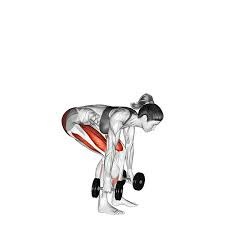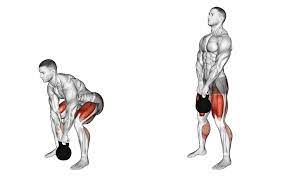Using the Hex Bar for Deadlifts.
If you are looking to add some new exercises to your routine, or you want to try something different than the traditional deadlift, the hex bar deadlift may be perfect for you. This exercise has many benefits, and it works a variety of muscles. In this guide, we will discuss how to do a hex bar deadlift, as well as the muscles it works. Let's get started!
Benefits of the hex bar deadlift
There are many benefits to incorporating hex bar deadlifts into your training routine. Here are just a few:
-Builds Strength: The hex bar deadlift is a great exercise for building strength in the lower body. By using a heavier weight than you would for a traditional deadlift, you can really challenge your muscles and see some serious strength gains.
-Improves Balance: The hex bar deadlift forces you to use both sides of your body equally, which can help to improve your overall balance.
-Corrects Muscle Imbalances: As mentioned above, the hex bar deadlift can help to correct imbalances between the quads and hamstring groups. This is due to the fact that both groups are worked evenly in this exercise.
How to do a Hex Bar deadlift
Now that we've discussed the benefits of the hex bar deadlift, let's talk about how to do it. First, you will need to find a hex bar. These bars are typically found in most gyms. If your gym does not have one, you may be able to purchase one online or at a local sporting goods store.
Step One: Position the hex bar in the middle of your feet, making sure that it’s centred.
Step Two: Bend down and grip the hex bar with both hands, using an overhand grip. Your hands should be shoulder-width apart.
Step Three: Keeping your back straight, lift the hex bar up until you’re standing tall. Be sure to keep your core engaged throughout the movement.
Step Four: Lower the hex bar back down to the starting position, and repeat for the desired number of reps.
Hex Bar Deadlifts vs Regular Deadlifts
So, what’s the difference between regular deadlifts and hex bar deadlifts?
For starters, the hex bar allows you to keep your hands in a neutral position (i.e., at your sides), which takes stress off of your shoulders and puts you in a better overall lifting position.
Additionally, because the weight is centred in the middle of your feet with the hex bar, it’s easier to maintain balance throughout the movement. This is especially helpful if you’re new to lifting or have any issues with coordination.
Finally, due to the mechanics of the hex bar deadlift, you’re able to lift more weight than you would with a regular deadlift. So if your goal is to build strength and muscle, this exercise is a great option.
Muscles Worked with Hex Bar Deadlift
The hex bar deadlift is a great exercise for building strength and size in the posterior chain, which includes the muscles of the back, glutes, and hamstrings. This movement can also help to improve your squat and deadlift numbers as it strengthens the muscles and connective tissues used in those exercises. In addition, the hex bar deadlift can help to correct imbalances between the quads and hamstring groups.
Alternatives to Hex Bar Deadlifts
Barbell Deadlift: If you don’t have access to a hex bar, or if you’re looking for a more traditional deadlift option, the barbell deadlift is a great choice.
How to do a barbell deadlift: Step up to the barbell so that it’s centered over your feet. Bend at your hips and knees, and grip the bar with your hands shoulder-width apart.
Keeping your lower back in its natural arch, lift the bar off the ground by extending your hips and knees until you’re standing upright. Reverse the motion to return to the starting position.
Dumbbell Deadlift: The dumbbell deadlift is another great alternative to the hex bar deadlift. This exercise can be done with one or two dumbbells.
How to do a dumbbell deadlift: Start by standing with a dumbbell in each hand, palms facing your thighs. Bend at your hips and knees, and lower the dumbbells to the floor. Keeping your back in its natural arch, stand up by extending your hips and knees. Reverse the motion to return to the starting position.
Kettlebell Deadlift: The kettlebell deadlift is another alternative to the hex bar deadlift, and is a great exercise for those who are looking for a more challenging lift.
How to do a kettlebell deadlift: Start by standing with a kettlebell in each hand, palms facing your thighs. Bend at your hips and knees, and lower the kettlebells to the floor. Keeping your back in its natural arch, stand up by extending your hips and knees. Reverse the motion to return to the starting position.
No matter which exercise you choose, be sure to start light and increase the weight gradually. Deadlifts are a great exercise for building strength and muscle, but they can also be dangerous if you don’t use the proper form. If you have any doubts about your form, please consult a qualified personal trainer or coach before attempting this exercise.
What are some tips for performing hex bar deadlifts?
Some tips for performing hex bar deadlifts include using a pronated grip (palms facing down), keeping your shoulders back and down, and maintaining a neutral spine. It is also important to keep the bar close to your shins and drive through your heels. Start with light weight and gradually increase the amount of weight you lift as you get stronger. Hex bar Deadlifts are an extremely effective exercise for building strength and muscle mass. Follow these tips to make sure you are doing them correctly!
Conclusion
Hex bar Deadlifts are a great exercise for building strength and muscle due to the mechanics of the movement. If you're looking to add a hex bar deadlift to your workout routine, be sure to start light and gradually increase the weight as you get comfortable with the movement. As always, consult with a certified trainer or doctor before beginning any new exercise program.
Hex Bar Deadlift FAQs
Are there any risks with using a hex bar for deadlifts?
There are always risks associated with any type of weightlifting, but using a hex bar for deadlifts is no riskier than using a regular barbell. Always use proper form and technique when lifting any weight to avoid injury.
Can I use a hex bar for other exercises?
Yes, you can use a hex bar for other exercises such as squats, presses, and rows. Be sure to consult with a certified trainer or doctor before adding any new exercise to your routine.
What's the difference between a hex bar deadlift and a conventional deadlift?
The main difference between a hex bar deadlift and a conventional deadlift is the position of the hands. In a conventional deadlift, the hands are gripping the barbell in front of the shins, whereas in a hex bar deadlift, the hands are gripping the handles at shoulder width. This change in hand position alters the biomechanics of the exercise and puts less stress on the lower back.
Where can I buy a hex bar?
Hex bars can be purchased at most sporting goods stores or online. They are relatively inexpensive and are a great addition to any home gym.
What are some other hex bar exercises?
In addition to the hex bar deadlift, other common exercises that can be performed with a hex bar include shoulder presses, squats, lunges, and rows.
How do I add weight to the hex bar?
Weight plates can be added to the ends of the hex bar just as they would be added to a conventional barbell. Start with a lighter weight and gradually increase the amount of weight as you get stronger.
Do hex bars take Olympic weight plates?
Yes, hex bars can accommodate both standard and Olympic weight plates.
What is the difference between a hex bar and a trap bar?
The main difference between a hex bar and a trap bar is the shape. A hex bar has two handles that are parallel to each other, while a trap bar has four handles that are perpendicular to each other. This difference in shape allows you to perform the hex bar deadlift with a neutral grip, which is easier on your shoulders than a pronated grip.
How much does a hex bar weigh?
Hex bars typically weigh between 30 and 50 pounds.
How should I start with hex bar deadlifts?
If you are new to hex bar deadlifts, start with a light weight and focus on perfecting your form. Once you have mastered the proper form, you can increase the weight.
Do the majority of commercial gyms have hex bars?
Yes, most commercial gyms will have a hex bar.
What are some of the benefits of hex bar deadlifts?
Some of the benefits of hex bar deadlifts include increased muscle mass, improved grip strength, and reduced risk of injury. Hex bar deadlifts also allow you to lift more weight than traditional deadlifts.
What muscles does the hex bar Deadlift work?
The hex bar Deadlift works your quads, hamstrings, glutes, lower back, lats, traps, and forearms.
Can I use resistance bands with hex bar deadlifts?
Yes, you can use resistance bands with hex bar deadlifts to increase the difficulty of the exercise.
Can I use a hex bar for rack pulls?
Yes, you can use a hex bar for rack pulls. Rack pulls are a variation of the deadlift that is performed with the weight starting at knee level.









.png)



